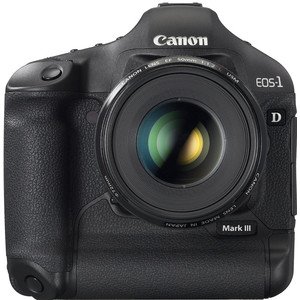Canon’s EOS-1D Mark II (successor to the original EOS-1D) is the ultimate professional digital SLR. Nearly doubling its predecessor’s resolution to 8.2 megapixels, it also offers an improved shooting buffer for continuous shooting 8.5 frames per second at full resolution–making it the world’s fastest digital SLR (as of January, 2004). It also features a faster DIGIC II imaging engine, a rugged yet lightweight weather-resistant magnesium alloy construction, capability for custom and personal presets, and dual storage slots for CompactFlash and Secure Digital cards.
Sensor: APS-H
Canon 1D Mark II N
Record-Breaking SpeedWorld’s fastest digital SLR. 8.5 fps for up to 48 full-resolution JPEGs in a burst. Canon’s new EOS-1D Mark II N can record 8.5 frames-per-second for up to 48 frames in one burst. It features Canon’s proven 8.2 Megapixel CMOS sensor with a 1.3x conversion factor, combined with the speed and intelligence of the DIGIC II Image Processor, all in a rock-solid, metal body. Adding the ability to record RAW and JPEG images on different memory cards, a larger 2.5 inch LCD, Canon’s “Picture Style” technology and more, the 1D Mark II N’s formidable combination of speed and resolution makes it the choice of pros everywhere. World’s fastest digital SLR*: 8.5 fps for up to 48 full-resolution JPEGs in a burst. 8.2 Megapixel CMOS Sensor with a convenient 1.3x lens conversion factor, combined with DIGIC II Image Processor for outstanding image quality. Superb body design and strength – all-metal body and chassis, weather-resistant construction and shutter durability – tested to 200,000 exposures. New larger 2.5 inch LCD screen can be viewed even at extreme angles up to 170°. Many new user-requested features, including RAW + JPEG recording on separate memory cards, easy switching between memory cards and user-set file prefixes. New “Picture Style” function for greater control of color rendition and in-camera sharpening.
Canon 1D Mark III
The Canon EOS-1D Mark III has a 10.1 Megapixel CMOS sensor (APS-H size) with Canon’s EOS Integrated Cleaning System and a 3.0-inch LCD monitor with Canon’s Live View technology. The Self-Cleaning Sensor Unit is used against stray dust that enters the camera and adheres to the image sensor during a lens change. The IR-cut filter cleans itself automatically with ultrasonic vibrations, removing dust from the sensor assembly. The EOS-1D Mark III has a redesigned 100% viewfinder, a new 45-point AF system and can shoot up to 10 fps continuously with a maximum burst of 110 shots. Dual DIGIC III Image Processors work in tandem to speed up every process while refining image quality, a new, lighter body has improved weather sealing and shutter durability. Every facet of the EOS experience has been enhanced with the 1D Mark III. Image Sensor Type – High-sensitivity, high-resolution, single-plate, CMOS sensor Aspect Ratio – 3/2 (Horizontal/Vertical) Color Filter System – RGB primary color filters Recording Format – DCF 2.0 (Exif 2.21) JPEG, RAW and RAW+JPEG simultaneous USB 2.0 Hi-Speed mini-B port NTSC & PAL for video output Viewfinder – Eye-level SLR with fixed pentaprism ISO – Up to 6400 AE Lock applies in One-Shot AF mode with evaluative metering when focus is achieved Optional External Speedlite – E-TTL II autoflash with all EX Series Speedlites Self-timer – 10 seconds, 2 seconds delay Battery Power Source – LP-E4 lithium-ion battery Automatic Battery Check Power Saving – Power turns off after 1, 2, 4, 8, 15 & 30 minutes Back-up Battery – One CR2025 lithium battery Dimensions – Width 6.1 x Height 6.2 x Depth 3.1 inch (156 x 156.6 x 79.9mm) Weight – 40.7 ounces (1155 grams)
Canon 1D Mark IV
Similar to the D3, the D300 features Nikon’s exclusive EXPEED Image Processing System that is central to driving the speed and processing power needed for many of the camera’s new features. The D300 features a new 51-point autofocus system with Nikon’s 3D Focus Tracking feature and two new LiveView shooting modes that allow users to frame a photograph using the camera’s high-resolution LCD monitor. The D300 shares a similar Scene Recognition System as is found in the D3; it promises to greatly enhance the accuracy of autofocus, autoexposure, and auto white balance by recognizing the subject or scene being photographed and applying this information to the calculations for the three functions.


